Effect of the Surface Morphology of Porous Coatings on Secondary Electron Yield of Metal Surface
Abstract
1. Introduction
2. Materials and Methods
3. Results
3.1. The Characterization of Surface Morphology
3.2. The Measurements of Secondary Electron Yield
4. Discussion
5. Conclusions
Author Contributions
Funding
Institutional Review Board Statement
Informed Consent Statement
Data Availability Statement
Acknowledgments
Conflicts of Interest
Appendix A
| Scheme | Scheme | Scheme | |||
|---|---|---|---|---|---|
| A1-100n * | 1.95 | B1-100n | 1.98 | C1-100n | 1.50 |
| A2-100n | 1.94 | B2-100n | 1.96 | C2-100n | 1.42 |
| A3-100n | 1.52 | B3-100n | 1.43 | C3-100n | 1.28 |
| A4-100n | 1.47 | B4-100n | 1.50 | C4-100n | 1.35 |
| A5-100n | 1.47 | B5-100n | 1.40 | C5-100n | 1.36 |
| D1-100n | 1.39 | E1-100n | 1.44 | F1-100n | 1.51 |
| D2-100n | 1.39 | E2-100n | 1.34 | F2-100n | 1.38 |
| D3-100n | 1.40 | E3-100n | 1.36 | F3-100n | 1.35 |
| D4-100n | 1.17 | E4-100n | 1.35 | F4-100n | 1.45 |
| D5-100n | 1.47 | E5-100n | 1.41 | F5-100n | 1.95 |
| Scheme | Scheme | Scheme | |||
|---|---|---|---|---|---|
| A1-500n * | 2.14 | B1-500n | 2.00 | C1-500n | 2.07 |
| A2-500n | 2.01 | B2-500n | 2.00 | C2-500n | 2.02 |
| A3-500n | 1.96 | B3-500n | 2.00 | C3-500n | 1.98 |
| A4-500n | 2.08 | B4-500n | 2.06 | C4-500n | 1.47 |
| A5-500n | 2.03 | B5-500n | 2.04 | C5-500n | 1.96 |
| D1-500n | 2.02 | E1-500n | 2.06 | F1-500n | 2.00 |
| D2-500n | 2.10 | E2-500n | 1.44 | F2-500n | 1.95 |
| D3-500n | 1.95 | E3-500n | 1.48 | F3-500n | 2.04 |
| D4-500n | 1.26 | E4-500n | 1.56 | F4-500n | 2.00 |
| D5-500n | 1.50 | E5-500n | 2.03 | F5-500n | 2.07 |
References
- Cui, W.Z.; Li, Y.D.; Yang, J.; Hu, T.C.; Wang, X.B. An efficient multipaction suppression method in microwave components for space application. Chin. Phys. B 2016, 25, 068401. [Google Scholar] [CrossRef]
- Marić, D.; Savić, M.; Sivoš, J.; Škoro, N.; Radmilović-Radjenović, M.; Malović, G.; Petrović, Z.L. Gas breakdown and secondary electron yields. Eur. Phys. J. D 2014, 68, 155. [Google Scholar] [CrossRef]
- Marcak, A.; Corbella, C.; Arcos, T.; Keudell, A.V. Note: Ion-induced secondary electron emission from oxidized metal surfaces measured in a particle beam reactor. Rev. Sci. Instrum. 2015, 86, 106102. [Google Scholar] [CrossRef] [PubMed]
- Sorolla, E.; Sounas, A.; Mattes, M. Space charge effects for multipactor in coaxial lines. Phys. Plasmas 2015, 22, 033512. [Google Scholar] [CrossRef]
- Li, Y.; Cui, W.Z.; Wang, H.G. Simulation investigation of multipactor in metal components for space application with an improved secondary emission model. Phys. Plasmas 2015, 22, 053108. [Google Scholar]
- Kanaya, K.; Kawakatsu, H. Secondary electron emission due to primary and backscattered electrons. J. Phys. D Appl. Phys. 1972, 5, 1727–1742. [Google Scholar] [CrossRef]
- Shih, A.; Yater, J.; Hor, C.; Abrams, R. Secondary electron emission studies. Appl. Surf. Sci. 1997, 111, 251–258. [Google Scholar] [CrossRef]
- Díaz, N.; Casrañeda, S.; Montero, I.; Galán, L.; Rueda, F. Coating to Prevent Multipactor Effect in RF High Power Components for Space; Final Report, ESA-ESTEC Contract P.O.162594(1996); ESA: Paris, France, 1998. [Google Scholar]
- Díaz, N.; Casrañeda, S.; Ripalda, J.M.; Montero, I.; Galán, L.; Feltham, S.; Rabosa, D.; Rueda, F. Materials of low secondary electron emission to prevent the multipactor effect in high-power RF devices in space. In Proceedings of the 6th Spacecraft Charging Technology Conference, Bedford, MA, USA, 2–6 November 1998; pp. 205–209. [Google Scholar]
- Grosso, D.R.; Commisso, M.; Cimino, R.; Larciprete, R.; Flammini, R.; Wanzenberg, R. Effect of the surface processing on the secondary electron yield of Al alloy samples. Phys. Rev. Spec. Top. Accel. Beams 2013, 16, 051003. [Google Scholar] [CrossRef]
- Sian, T.; Lin, Y.; Valizadeh, R.; Malyshev, O.B.; Xia, G.X.; Valles, C.; Yu, G.L.; Kinloch, I. Graphene coating for the reduction of the secondary electron yield. In Proceedings of the 7th International Particle Accelerator Conference, Busan, Korea, 8–13 May 2016. [Google Scholar]
- Xie, G.B.; Cui, W.Z.; Yang, J. A general route towards secondary electron yield suppression based on graphene. In Proceedings of the 17th International Symposium on Antenna Technology and Applied Electromagnetics, Montreal, QC, Canada, 10–13 July 2016. [Google Scholar]
- Luo, J.; Tian, P.; Pan, C.T.; Robertson, A.W.; Warner, J.H.; Hill, E.W.; Briggs, G.A.D. Ultralow secondary electron emission of graphene. ACS Nano 2011, 5, 1047–1055. [Google Scholar] [CrossRef]
- Pinto, P.C.; Calatroni, S.; Neupert, H.; Letant-Delrieux, D.; Edwards, P.; Chiggiato, P.; Taborelli, M.; Vollenberg, W.; Yin-Vallgren, C.; Colaux, J.L.; et al. Carbon coatings with low secondary electron yield. Vacuum 2013, 98, 29–36. [Google Scholar] [CrossRef]
- Characterization of carbon coatings with low secondary electron yield. In Proceedings of the 2nd International Particle Accelerator Conference, San Sebastián, Spain, 4–9 September 2011.
- Montero, I.; Aguilera, L.; Dávila, M.E.; Nistor, V.C.; González, L.A.; Galán, L.; Raboso, D.; Ferritto, R. Secondary electron emission under electron bombardment from graphene nanoplatelets. Appl. Surf. Sci. 2014, 291, 74–77. [Google Scholar] [CrossRef]
- Riccardi, P.; Cupolillo, A.; Pisarra, M.; Sindona, A.; Caputi, L.S. Primary energy dependence of secondary electron emission from grapheme adsorbed on Ni (111). Appl. Phys. Lett. 2012, 101, 183102. [Google Scholar] [CrossRef]
- Suetsugu, Y.; Fukuma, H.; Wang, L.; Pivi, M.; Morishige, A.; Suzuki, Y.; Tsukamoto, M.; Tsuchiya, M. Demonstration of electron clearing effect by means of a clearing electrode in high-intensity positron ring. Nucl. Instrum. Methods Phys. Res. Sect. A 2009, 598, 372–378. [Google Scholar] [CrossRef]
- Pivi, M.; King, F.K.; Kirby, R.E.; Raubenheimer, T.O.; Stupakov, G.; Pimpec, F.L. Sharp reduction of the secondary electron emission yield from grooved surfaces. J. Appl. Phys. 2008, 104, 104904. [Google Scholar] [CrossRef]
- Ye, M.; He, Y.N.; Hu, S.G.; Wang, R.; Hu, T.C.; Yang, J.; Cui, W.Z. Suppression of secondary electron yield by micro-porous array structure. J. Appl. Phys. 2013, 113, 074904. [Google Scholar]
- Chang, C.; Liu, G.Z.; Huang, H.J.; Chen, C.H.; Fang, J.Y. Suppressing high-power microwave dielectric multipactor by the sawtooth surface. Phys. Plasmas 2009, 16, 083501. [Google Scholar] [CrossRef]
- Chang, C.; Huang, H.J.; Liu, G.Z.; Chen, C.H.; Hou, Q.; Fang, J.Y.; Zhu, X.X.; Zhang, Y.P. The effect of grooved surface on dielectric multipactor. J. Appl. Phys. 2009, 105, 123305. [Google Scholar] [CrossRef]
- Chen, C.H.; Chang, C.; Liu, W.Y.; Sun, J.; Huang, H.J.; Ke, C.F.; Song, W.; Teng, Y.; Wu, X.L.; Xie, J.L.; et al. Improving the microwave window breakdown threshold by using a fluorinated, periodically patterned surface. J. Appl. Phys. 2013, 114, 163304. [Google Scholar] [CrossRef]
- Pivi, M.T.F.; Collet, G.; King, F.; Kirby, R.E.; Markiewicz, T.; Raubenheimer, T.O.; Seeman, J.; Pimpec, F.L. Experimental observations of in situ secondary electron yield reduction in the PEP-II particle accelerator beam line. Nucl. Instrum. Methods Phys. Res. Sect. A 2010, 621, 47–56. [Google Scholar] [CrossRef][Green Version]
- Suetsugu, Y.; Kanazawa, K.; Shibata, K.; Ishibashi, T.; Hisamatsu, H.; Shirai, M.; Terui, S. Design and construction of the Super KEKB vacuum system. Vacuum 2015, 121, 238–244. [Google Scholar] [CrossRef]
- Ye, M.; Wang, D.; He, Y.N. Mechanism of total electron emission yield reduction using a micro-porous surface. J. Appl. Phys. 2017, 121, 124901–124911. [Google Scholar]
- Alvarado, A.; Chang, H.Y.; Nadvornick, W.; Ghoniem, N.; Marian, J. Montel Carol raytracing method for calculating secondary electron emission from micro-architected surfaces. Appl. Surf. Sci. 2019, 478, 142–149. [Google Scholar] [CrossRef]
- Lu, Q.; Yu, B.; Hu, Z.Q.; He, Y.; Hu, T.C.; Zhao, Y.N.; Wang, Z.G.; Zhou, Z.Y.; Cui, W.Z.; Liu, M. Surface roughness evolution induced low secondary electron yield in carbon coated Ag/Al substrates for space microwave devices. Appl. Surf. Sci. 2020, 501, 144236. [Google Scholar] [CrossRef]
- Nistor, V.; Gonzáleza, L.A.; Aguilerab, L.; Montero, I.; Galán, L.; Wochner, U.; Raboso, D. Multipactor suppression by micro-structured gold/silver coatings for space applications. Appl. Surf. Sci. 2014, 315, 445–453. [Google Scholar] [CrossRef]
- Wu, D.D.; Ma, J.Z.; Bao, Y.; Cui, W.Z.; Hu, T.C.; Yang, J.; Bai, Y.R. Fabrication of porous Ag/TiO2/Au coatings with excellent multipactor suppression. Sci. Rep. 2017, 7, 43749. [Google Scholar] [CrossRef] [PubMed]
- Montero, I.; Olano, L.; Aguilera, L.; Dávila, M.E.; Wochner, U.; Raboso, D.; Martin-Iglesias, P. Low-secondary electron emission yield under electron bombardment of microstructured surfaces, looking for multipactor effect suppression. J. Electron. Spectrosc. Relat. Phenom. 2020, 241, 146822. [Google Scholar] [CrossRef]
- Weng, M.; Cao, M.; Zhao, H.J.; Zhang, H.B. A simple charge neutralization method for measuring the secondary electron yield of insulators. Rev. Sci. Instrum. 2014, 85, 036108. [Google Scholar] [CrossRef]
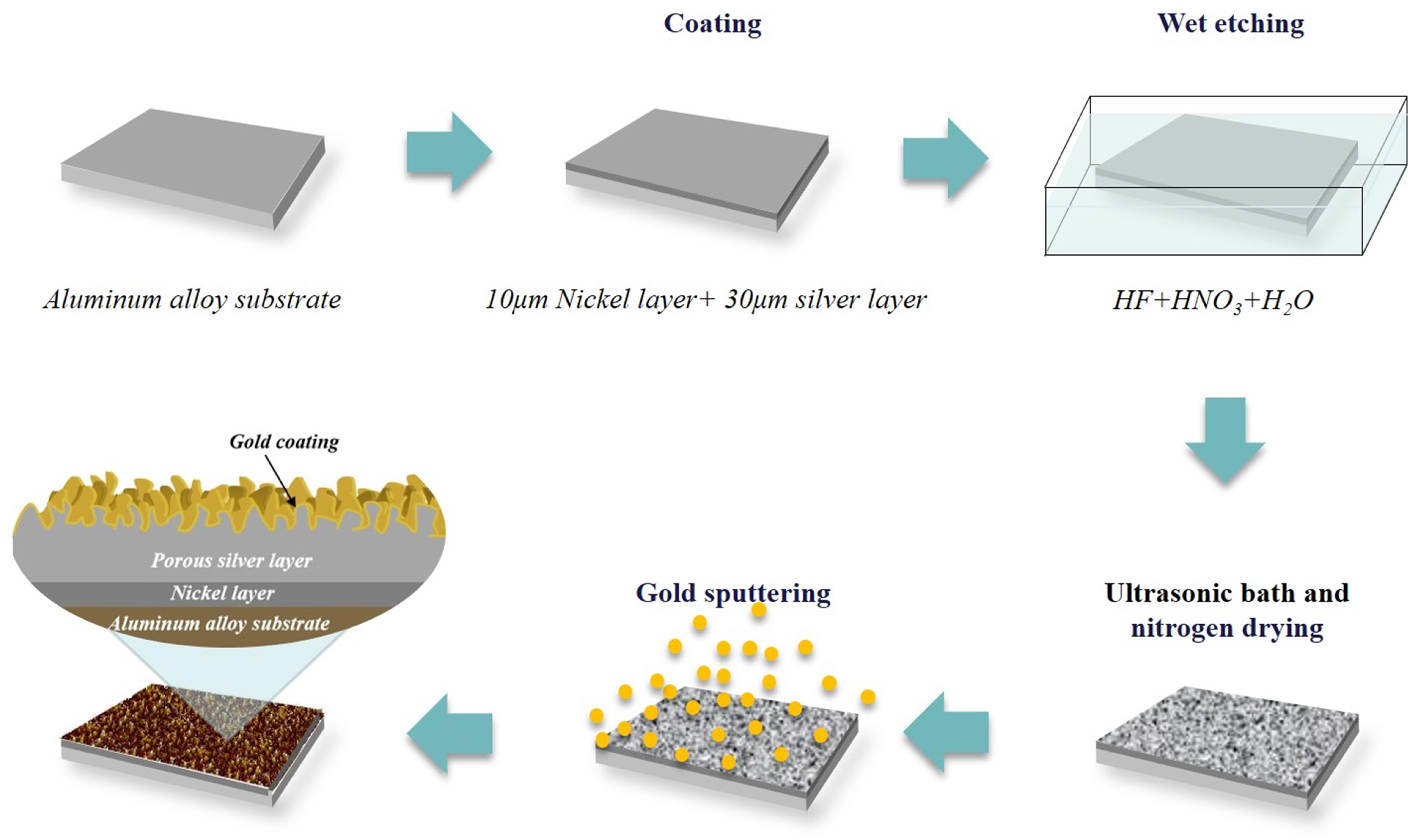


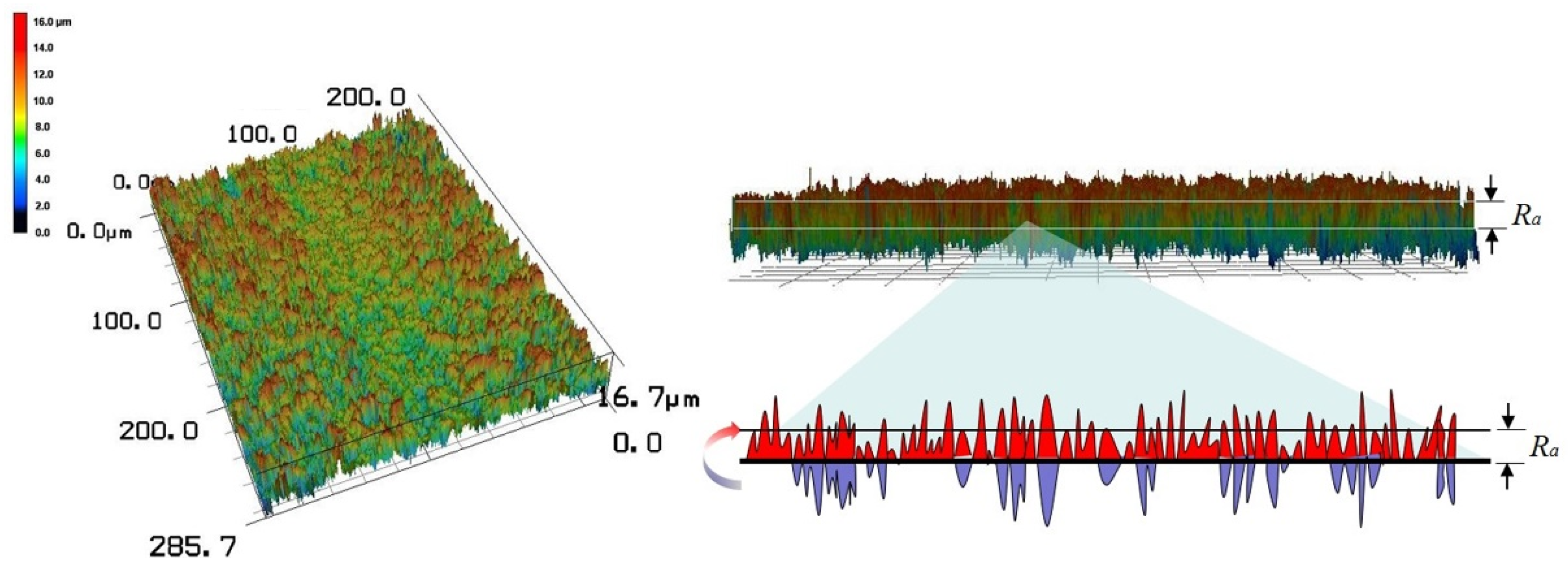
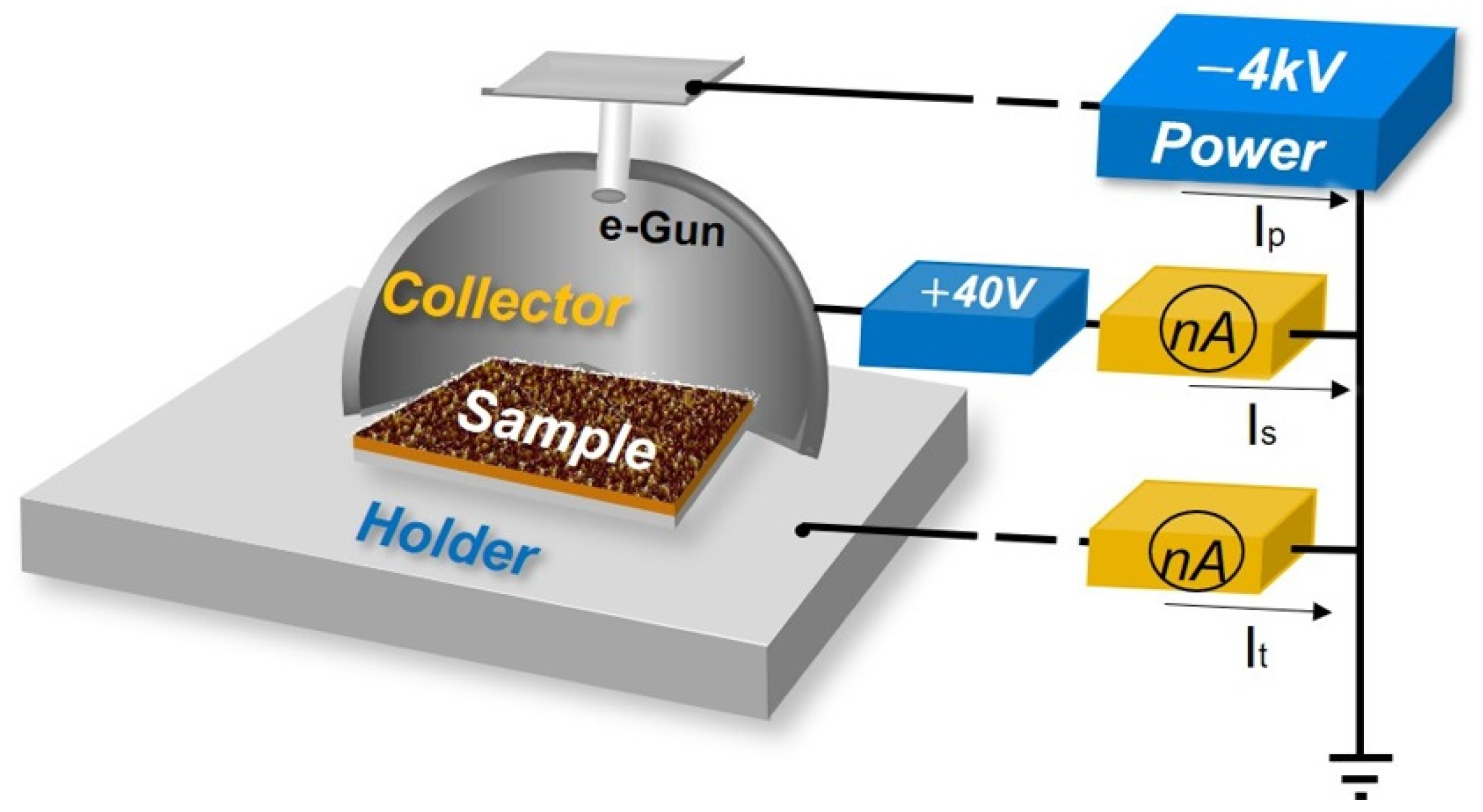
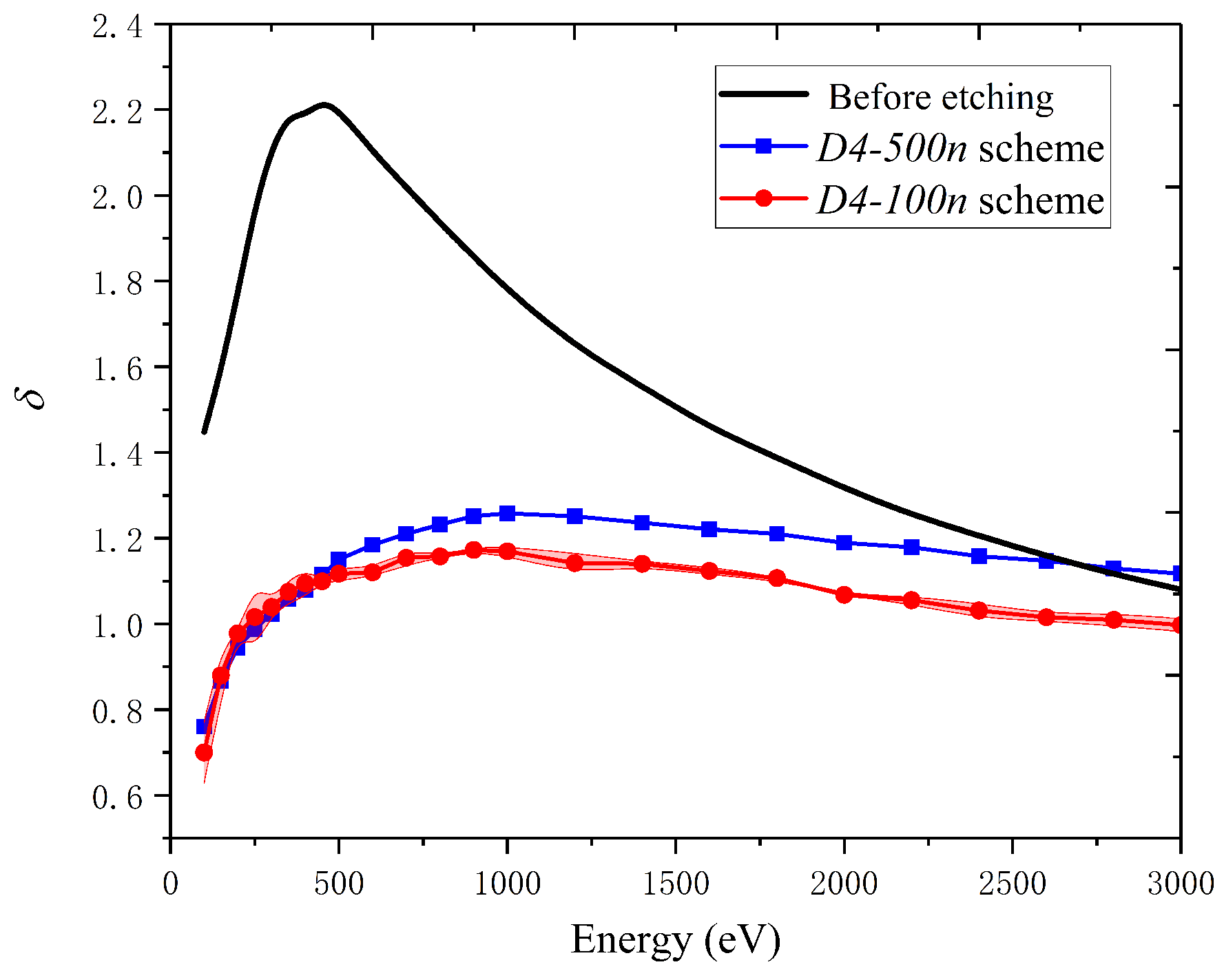
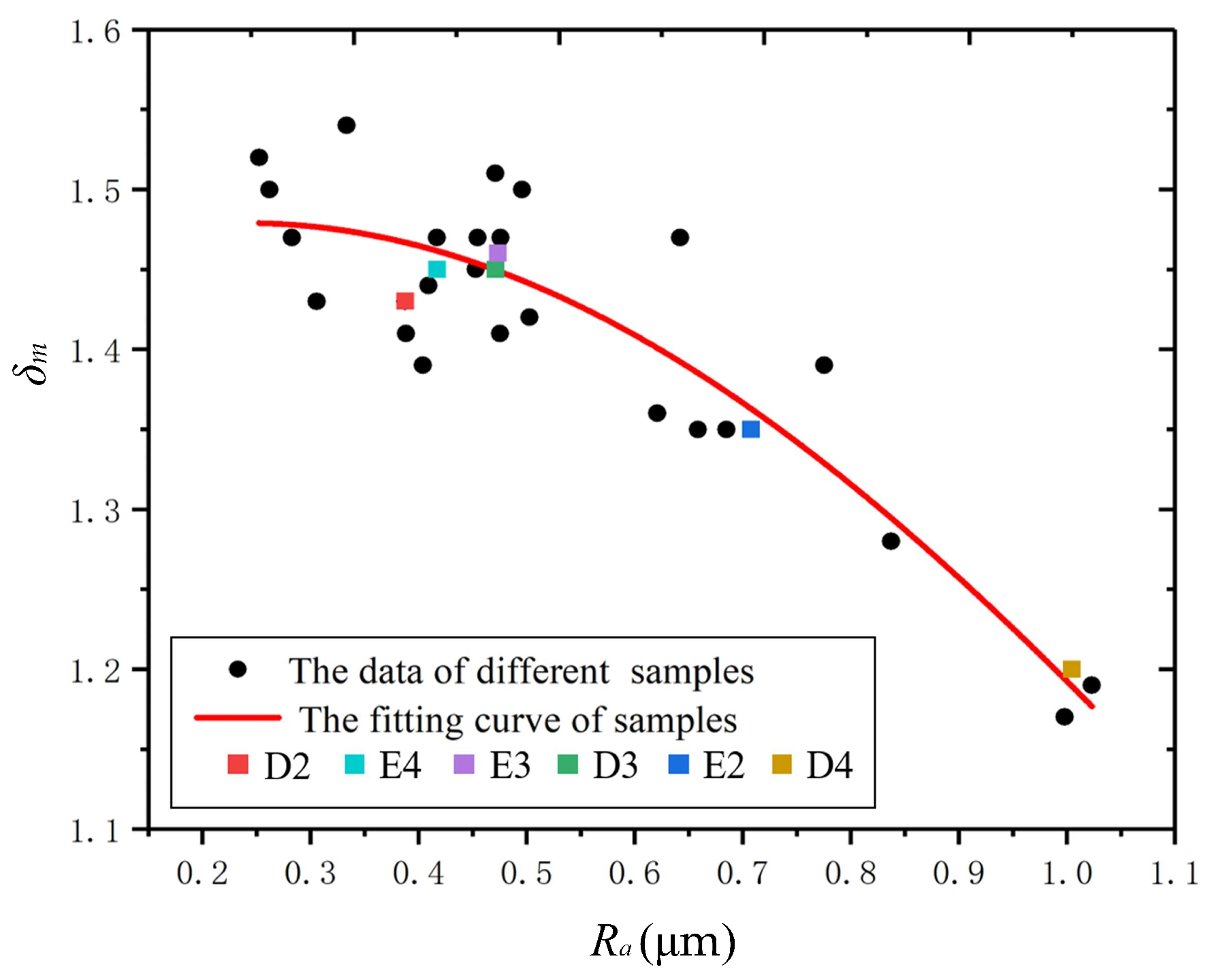
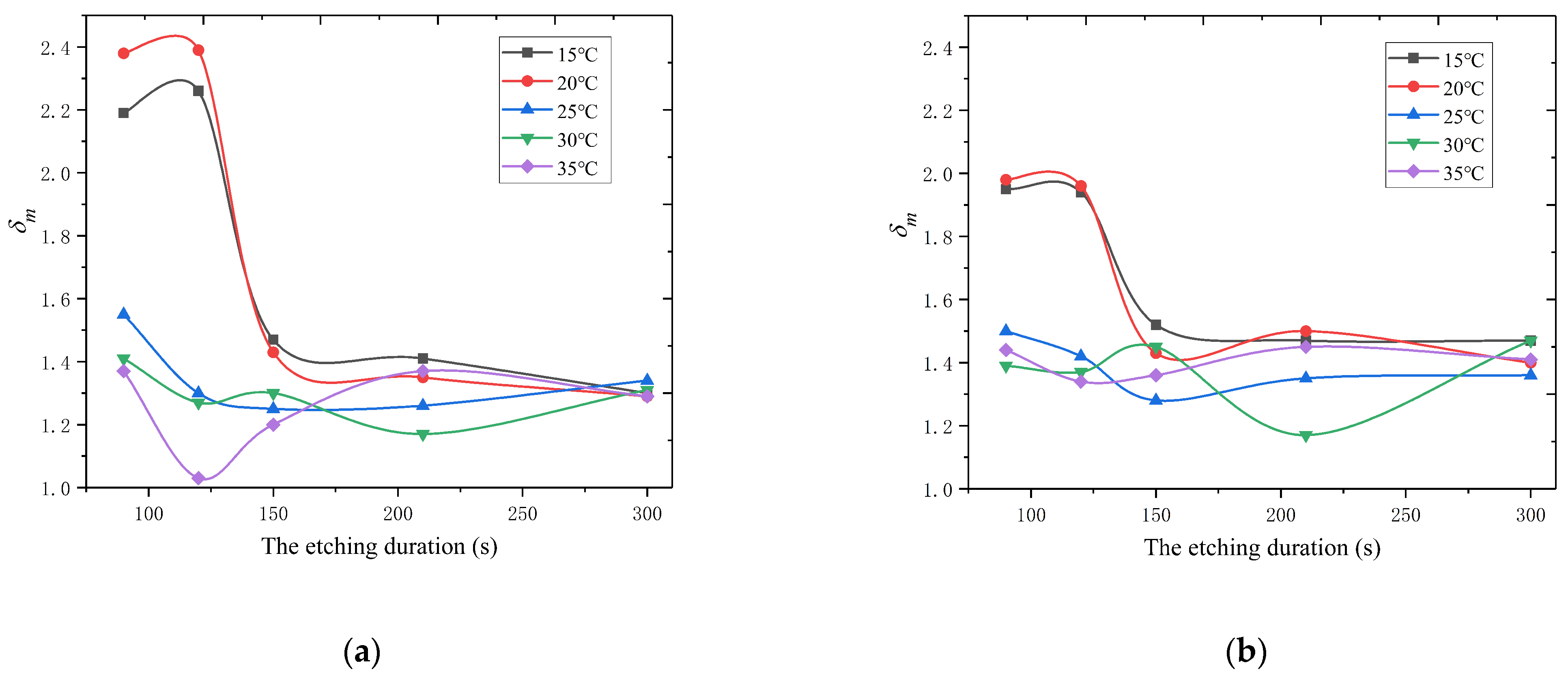

| Parameters | 15 °C | 20 °C | 25 °C | 30 °C | 35 °C | 40 °C |
|---|---|---|---|---|---|---|
| 90 s | A1 | B1 | C1 | D1 | E1 | F1 |
| 120 s | A2 | B2 | C2 | D2 | E2 | F2 |
| 150 s | A3 | B3 | C3 | D3 | E3 | F3 |
| 210 s | A4 | B4 | C4 | D4 | E4 | F4 |
| 300 s | A5 | B5 | C5 | D5 | E5 | F5 |
| Schemes Label | D2-100n * | E2-100n | D3-100n | E3-100n | D4-100n | E4-100n |
|---|---|---|---|---|---|---|
| (μm) | 0.9 | 1.3 | 1.2 | 1.2 | 1.0 | 1.1 |
| (μm) | 0.3876 | 0.7075 | 0.4712 | 0.4733 | 1.0046 | 0.4170 |
| Scheme | Scheme | Scheme | Scheme | ||||
|---|---|---|---|---|---|---|---|
| D2-100n * | 1.39 | E2-100n | 1.34 | D2-500n * | 2.10 | E2-500n | 1.44 |
| D3-100n | 1.40 | E3-100n | 1.36 | D3-500n | 1.95 | E3-500n | 1.48 |
| D4-100n | 1.17 | E4-100n | 1.35 | D4-500n | 1.26 | E4-500n | 1.56 |
| D5-100n | 1.47 | E5-100n | 1.41 | D5-500n | 1.50 | E5-500n | 2.03 |
| (μm) | Predicted SEY Values | Measured SEY Values | The Relative Deviation |
|---|---|---|---|
| 0.97 | 1.21 | 1.22 | 0.82% |
| 1.06 | 1.15 | 1.20 | 4.17% |
| 1.15 | 1.08 | 1.13 | 4.42% |
Publisher’s Note: MDPI stays neutral with regard to jurisdictional claims in published maps and institutional affiliations. |
© 2022 by the authors. Licensee MDPI, Basel, Switzerland. This article is an open access article distributed under the terms and conditions of the Creative Commons Attribution (CC BY) license (https://creativecommons.org/licenses/by/4.0/).
Share and Cite
Peng, M.; Lin, S.; Zhang, C.; Liang, H.; Liu, C.; Cao, M.; Hu, W.; Zhai, Y.; Li, Y. Effect of the Surface Morphology of Porous Coatings on Secondary Electron Yield of Metal Surface. Materials 2022, 15, 4322. https://doi.org/10.3390/ma15124322
Peng M, Lin S, Zhang C, Liang H, Liu C, Cao M, Hu W, Zhai Y, Li Y. Effect of the Surface Morphology of Porous Coatings on Secondary Electron Yield of Metal Surface. Materials. 2022; 15(12):4322. https://doi.org/10.3390/ma15124322
Chicago/Turabian StylePeng, Min, Shu Lin, Chuxian Zhang, Haifeng Liang, Chunliang Liu, Meng Cao, Wenbo Hu, Yonggui Zhai, and Yongdong Li. 2022. "Effect of the Surface Morphology of Porous Coatings on Secondary Electron Yield of Metal Surface" Materials 15, no. 12: 4322. https://doi.org/10.3390/ma15124322
APA StylePeng, M., Lin, S., Zhang, C., Liang, H., Liu, C., Cao, M., Hu, W., Zhai, Y., & Li, Y. (2022). Effect of the Surface Morphology of Porous Coatings on Secondary Electron Yield of Metal Surface. Materials, 15(12), 4322. https://doi.org/10.3390/ma15124322






